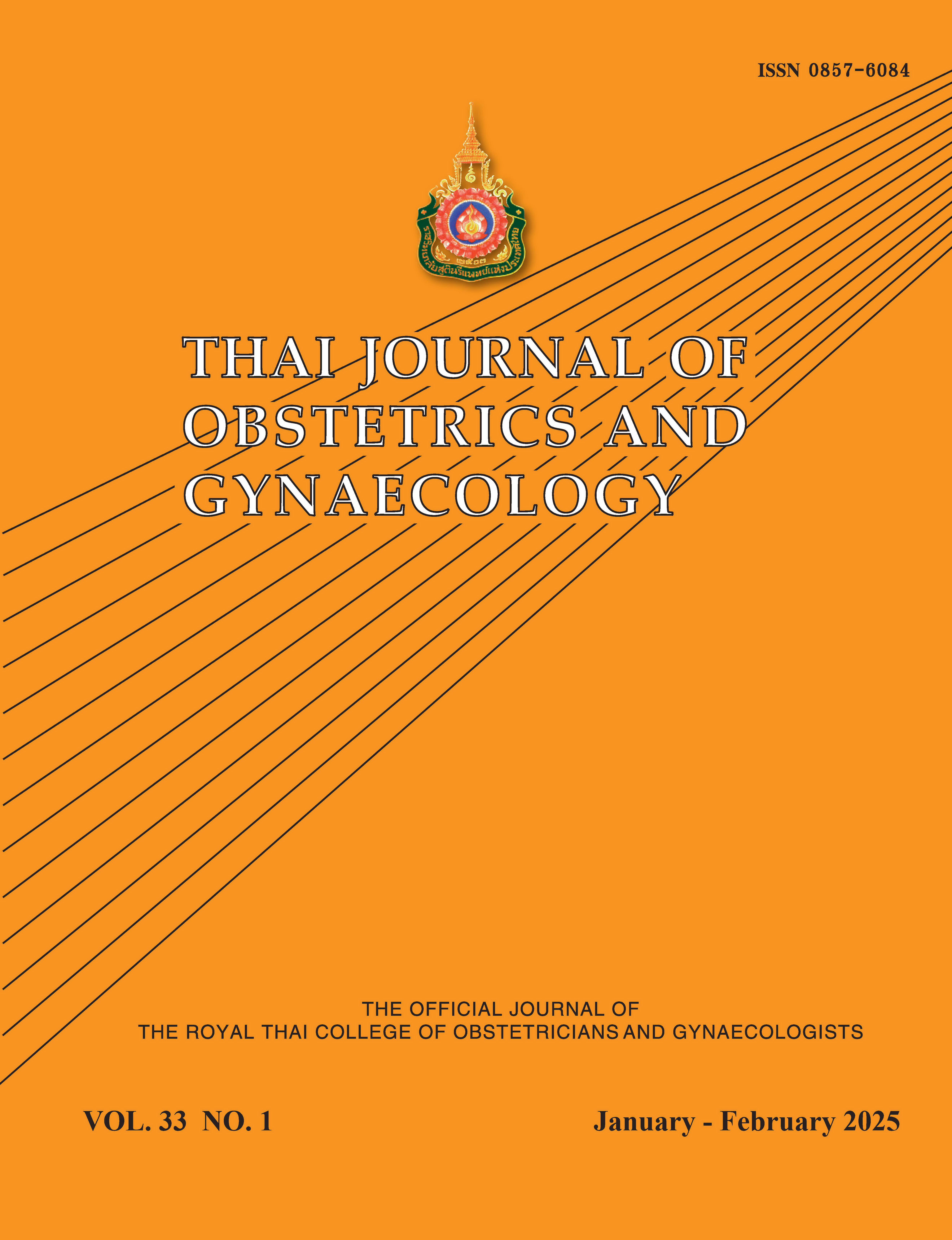Comparison of Depression Scores between Teenagers with Unintended Pregnancy Who Underwent Medical Abortion and Those Who Underwent Delivery in Ramathibodi Hospital using the Thai Edinburgh Postnatal Depression Scale
Main Article Content
Abstract
Objectives: The aim of this study was to compare teenagers with unintended pregnancy that terminated their pregnancy and those who delivered using the Thai Edinburgh Postnatal Depression Scale (EPDS) and determine predisposing factors for depression.
Materials and Methods: This cross-sectional study was conducted at a tertiary hospital between September 2018 and July 2019. Only data for unintended teenage pregnancies that underwent medical abortion or delivery were included. Exclusion criteria were intended pregnancy, history of major deressive disorder diagnosis, and refusal to participate. All participants completed the EPDS within 2 weeks after termination or delivery.
Results: In total, 131 teenage pregnancies were recorded over the study period. We excluded 10 intended pregnancies and one woman with history of major depressive disorder diagnosis. Sixty-five women underwent medical abortion (abortion group) and 55 underwent delivery (delivery group). Overall, there was no statistically significant difference in the total EPDS score between the two groups. There were 23 women (19.2%) with an EPDS score ≥ 11. The delivery group was more likely to have developed depression compared with the abortion group (25.4% vs 13.8%, risk ratio [RR] 0.87, 95% confidence interval [CI] 0.72-1.04). The delivery group was more likely to live with a partner than the abortion group (54.5% vs 9.2%, p < 0.01). Significant protective factors for postpartum depression were having family support (RR 2.26, 95%CI 1.16-3.27), continuing education (RR 1.27, 95%CI 1.07-1.51), and living with a partner (RR 1.20, 95%CI 1.03-1.41).
Conclusion: More teenagers with unintended pregnancy who delivered had postpartum depression than those who terminated their pregnancy, although the difference was not statistically significant. No family support, dropout from school, and living alone were predisposing factors for depression.
Article Details

This work is licensed under a Creative Commons Attribution-NonCommercial-NoDerivatives 4.0 International License.
References
Treatment and management of mental health conditions during pregnancy and postpartum. ACOG Clinical Practice Guideline No. 5. Obstet Gynecol 2023;141:1262-88.
ACOG Committee Opinion No. 757: Screening for perinatal depression. Obstet Gynecol 2018;132: e208-e12.
Bearak J, Popinchalk A, Ganatra B, Moller AB, Tunçalp Ö, Beavin C, et al. Unintended pregnancy and abortion by income, region, and the legal status of abortion: estimates from a comprehensive model for 1990-2019. Lancet Glob Health 2020;8:e1152-e61.
Yohannes E, Balis B. Unintended pregnancy and associated factors among women who live in Ilu Gelan District, Western Ethiopia, 2021. Int J Reprod Med 2022;2022:8646724.
Ayele A, Abdurashid N, Hailu M, Tefera B. Unintended pregnancy and associated factors among pregnant women attending antenatal care unit in public health facilities of Dire Dawa City, Eastern Ethiopia, 2021. Obstet Gynecol Int 2023;2023:8100462.
Payne JL, Maguire J. Pathophysiological mechanisms implicated in postpartum depression. Front Neuroendocrinol 2019;52:165-80.
Shelke A, Chakole S. A review on risk factors of postpartum depression in India and its management. Cureus 2022;14:e29150.
Cox JL, Holden JM, Sagovsky R. Detection of postnatal depression. Development of the 10-item Edinburgh Postnatal Depression Scale. Br J Psychiatry 1987;150:782-6.
Pope CJ, Mazmanian D. Breastfeeding and postpartum depression: An overview and methodological recommendations for future research. Depress Res Treat 2016;2016:4765310.
Navaratne P, Foo XY, Kumar S. Impact of a high Edinburgh Postnatal Depression Scale score on obstetric and perinatal outcomes. Sci Rep 2016;6:33544.
Pitanupong J, Liabsuetrakul T, Vittayanont A. Validation of the Thai Edinburgh Postnatal Depression Scale for screening postpartum depression. Psychiatry Res 2007;149:253-9.
Vacharaporn K, Pitanupong J, Samangsri N. Development of the Edinburgh Postnatal Depression Scale Thai version. J Mental Health Thai 2003;11:164-9.
O’Hara MW, Swain AM. Rates and risk of postpartum depression—a meta-analysis. Int Rev Psychiatry 1996;8:37-54.
Gaynes BN, Gavin N, Meltzer-Brody S, Lohr KN, Swinson T, Gartlehner G, et al. Perinatal depression: prevalence, screening accuracy, and screening outcomes. Evid Rep Technol Assess (Summ) 2005;119:1-8.
Youngdee K, Roomruangwong C. Depression after childbirth among mothers with obstetric complications in King Chulalongkorn Memorial Hospital. Chula Med J 2016;60:561-74.
Phummanee N, Roomruangwong C. Postpartum depression teenage mothers: A study at Department of Medical Services, Sirindhorn Hospital, Bangkok. Chula Med J 2023;59:195-205.
Gebeyehu NA, Tegegne KD, Abebe K, Asefa Y, Assfaw BB, Adella GA, et al. Global prevalence of post-abortion depression: systematic review and meta-analysis. BMC Psychiatry 2023;23:786.
Smorti M, Ponti L, Pancetti F. A comprehensive analysis of post-partum depression risk factors: The role of socio-demographic, individual, relational, and delivery characteristics. Front Public Health 2019;7:295.
Mutiso SK, Murage A, Mwaniki AM. Factors associated with a positive depression screen after a miscarriage. BMC Psychiatry 2019;19:8.
Holopainen A, Hakulinen T. New parents’ experiences of postpartum depression: a systematic review of qualitative evidence. JBI Database System Rev Implement Rep 2019;17:1731-69.


